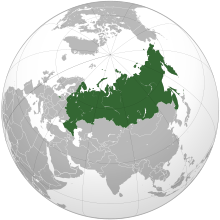No edit summary |
|||
| Line 1: | Line 1: | ||
[[ | [[File:Russia Globe.png]] | ||
== Background == | == Background == | ||
Revision as of 05:41, 5 April 2013
Background
There are multiple environmental issues facing Russia today. Most of the issues have been blamed on policies that were in effect during the Soviet Union. While the Soviet Union was in power Russia was undergoing industrialization massive economic development. Due to deforestation, pollution, nuclear waste and poaching, much of Russia’s land has begun to show signs of ecological stress.
Conservation
Russia currently has a total of over 33.5 million hectares dedicated to natural parks that are protected. However, Animals such as the polar bear, Amur tiger and Caucasian leopard are in danger of extinction. The Russian government is attempting to help revive those animal populations that are being threatened to the edge of extinction by deforestation and poachers.
Logging
According to the Center for Russian Environmental Policy, 16 million hectares of forest are destroyed each year to issues such as logging, fires and pollution. Roughly 1 billion dollars is lost each year to illegal logging. It is also estimated that 40% of harvested trees never get used do to ineffective clear-cutting strategies.
Energy
Russia also suffers from irresponsible energy usage and is dependent on the use of fossil fuels. Russia is a huge producer of fossil fuels and 68% of the energy in Russia comes from polluting fossil fuels.
Water
In Russia 75% of surface water and 50% of all water is polluted. This has resulted in the spread of disease through water and caused many health issues in the cities. Chemical and Industrial waste is also often dumped into waterways causing significant damage to the fish of the Caspian and Black seas.
Air Quality
Russia has one of the worst cases of air pollution in the world. Millions of tons of pollutants are released into the air from industrial centers and millions of vehicles. Respiratory and endocrine diseases are attributed to 10% of adults and 17% of children in Russia.
